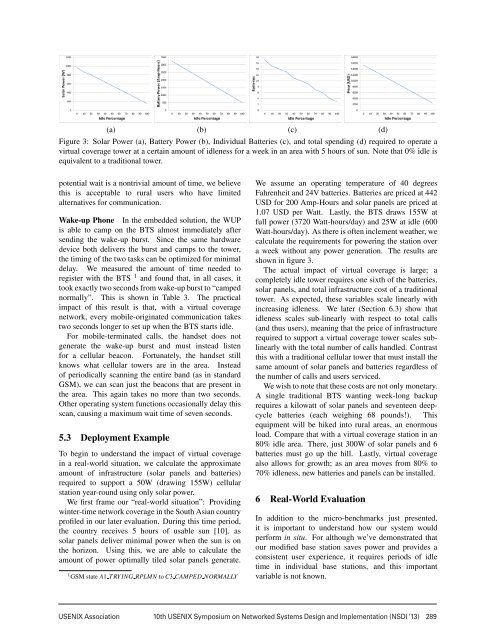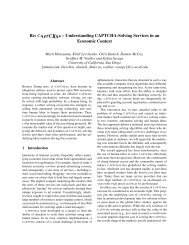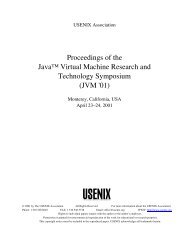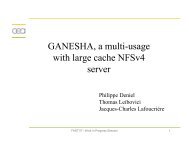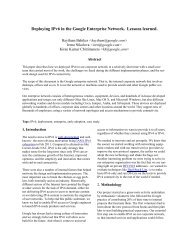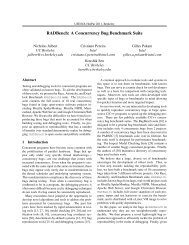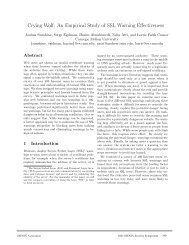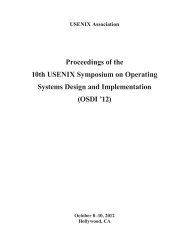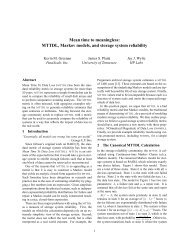Expanding Rural Cellular Networks with Virtual Coverage - Usenix
Expanding Rural Cellular Networks with Virtual Coverage - Usenix
Expanding Rural Cellular Networks with Virtual Coverage - Usenix
Create successful ePaper yourself
Turn your PDF publications into a flip-book with our unique Google optimized e-Paper software.
(a) (b) (c) (d)<br />
Figure 3: Solar Power (a), Battery Power (b), Individual Batteries (c), and total spending (d) required to operate a<br />
virtual coverage tower at a certain amount of idleness for a week in an area <strong>with</strong> 5 hours of sun. Note that 0% idle is<br />
equivalent to a traditional tower.<br />
potential wait is a nontrivial amount of time, we believe<br />
this is acceptable to rural users who have limited<br />
alternatives for communication.<br />
Wake-up Phone In the embedded solution, the WUP<br />
is able to camp on the BTS almost immediately after<br />
sending the wake-up burst. Since the same hardware<br />
device both delivers the burst and camps to the tower,<br />
the timing of the two tasks can be optimized for minimal<br />
delay. We measured the amount of time needed to<br />
register <strong>with</strong> the BTS 1 and found that, in all cases, it<br />
took exactly two seconds from wake-up burst to “camped<br />
normally”. This is shown in Table 3. The practical<br />
impact of this result is that, <strong>with</strong> a virtual coverage<br />
network, every mobile-originated communication takes<br />
two seconds longer to set up when the BTS starts idle.<br />
For mobile-terminated calls, the handset does not<br />
generate the wake-up burst and must instead listen<br />
for a cellular beacon. Fortunately, the handset still<br />
knows what cellular towers are in the area. Instead<br />
of periodically scanning the entire band (as in standard<br />
GSM), we can scan just the beacons that are present in<br />
the area. This again takes no more than two seconds.<br />
Other operating system functions occasionally delay this<br />
scan, causing a maximum wait time of seven seconds.<br />
5.3 Deployment Example<br />
To begin to understand the impact of virtual coverage<br />
in a real-world situation, we calculate the approximate<br />
amount of infrastructure (solar panels and batteries)<br />
required to support a 50W (drawing 155W) cellular<br />
station year-round using only solar power.<br />
We first frame our “real-world situation”: Providing<br />
winter-time network coverage in the South Asian country<br />
profiled in our later evaluation. During this time period,<br />
the country receives 5 hours of usable sun [10], as<br />
solar panels deliver minimal power when the sun is on<br />
the horizon. Using this, we are able to calculate the<br />
amount of power optimally tiled solar panels generate.<br />
1 GSM state A1 TRYING RPLMN to C3 CAMPED NORMALLY<br />
We assume an operating temperature of 40 degrees<br />
Fahrenheit and 24V batteries. Batteries are priced at 442<br />
USD for 200 Amp-Hours and solar panels are priced at<br />
1.07 USD per Watt. Lastly, the BTS draws 155W at<br />
full power (3720 Watt-hours/day) and 25W at idle (600<br />
Watt-hours/day). As there is often inclement weather, we<br />
calculate the requirements for powering the station over<br />
a week <strong>with</strong>out any power generation. The results are<br />
shown in figure 3.<br />
The actual impact of virtual coverage is large; a<br />
completely idle tower requires one sixth of the batteries,<br />
solar panels, and total infrastructure cost of a traditional<br />
tower. As expected, these variables scale linearly <strong>with</strong><br />
increasing idleness. We later (Section 6.3) show that<br />
idleness scales sub-linearly <strong>with</strong> respect to total calls<br />
(and thus users), meaning that the price of infrastructure<br />
required to support a virtual coverage tower scales sublinearly<br />
<strong>with</strong> the total number of calls handled. Contrast<br />
this <strong>with</strong> a traditional cellular tower that must install the<br />
same amount of solar panels and batteries regardless of<br />
the number of calls and users serviced.<br />
We wish to note that these costs are not only monetary.<br />
A single traditional BTS wanting week-long backup<br />
requires a kilowatt of solar panels and seventeen deepcycle<br />
batteries (each weighing 68 pounds!). This<br />
equipment will be hiked into rural areas, an enormous<br />
load. Compare that <strong>with</strong> a virtual coverage station in an<br />
80% idle area. There, just 300W of solar panels and 6<br />
batteries must go up the hill. Lastly, virtual coverage<br />
also allows for growth; as an area moves from 80% to<br />
70% idleness, new batteries and panels can be installed.<br />
6 Real-World Evaluation<br />
In addition to the micro-benchmarks just presented,<br />
it is important to understand how our system would<br />
perform in situ. For although we’ve demonstrated that<br />
our modified base station saves power and provides a<br />
consistent user experience, it requires periods of idle<br />
time in individual base stations, and this important<br />
variable is not known.<br />
7<br />
USENIX Association 10th USENIX Symposium on Networked Systems Design and Implementation (NSDI ’13) 289


